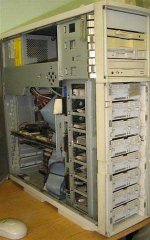From what I remember the Pentium took off (home use) around the time the P133 was released, before that systems were kind of pricey and people were still using high end cheap 486's. The older models (especially the 60/66) were not that common and judging by what I had seen at recyclers most pentium systems were 166 and 233MMX with a few Cyrix in the mix.
So how many people actually have the older models in their collection (machines not just CPU) and what do you use them for if anything?
I had a gigantic (hugest tower case I've ever seen) Acer Altos 9000 Server. It had a Dual Pentium 60 processors with fans and heat sinks (the small tiny ones). It was gigantic. I acutally just found a picture of it online (although looks rather gutted in this picture)

In any case, I've long since gotten rid of it. I'd have loved to keep it, but it was so huge that it really didn't make sense for me to keep it.
The thing had 8 removable hot-swappable full height 3.5" drive bays. It had a built in Ultra-Wide SCSI controller, a normal SCSI-2 controller, two IDE ports (4 IDE devices), a floppy controller, 6 or 8 ram slots (I think), three external 5.25" drive bays, and a single 3.5" drive bay.
The thing had four legs that would swing out at the bottom to help support it. It also had wheels in the back, and a handle in the front on the top that you would pull out and you could wheel it around like a huge 50 pound suit case. The thing weighed a ridiculous amount... probably around 50 pounds. It really sucked on the rare occasions that I had to move the computer somewhere (like to go play Network Doom or something).
The picture above doesn't show it, but the computer also had two doors that covered the drive bays top and bottom.
Strangely enough, I actually have another Acer Altos server... no idea what model it is, but it's basically a slightly newer version of that computer above, and without all of the hot swappable drive bays. It's like half the height, and while it does have the legs that swing out, it doesn't have wheels or a handle.. hah... I guess it's somewhere in between a full tower and a mid tower.

